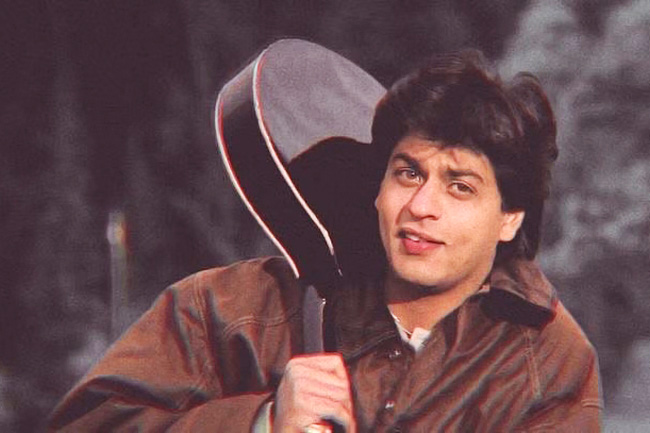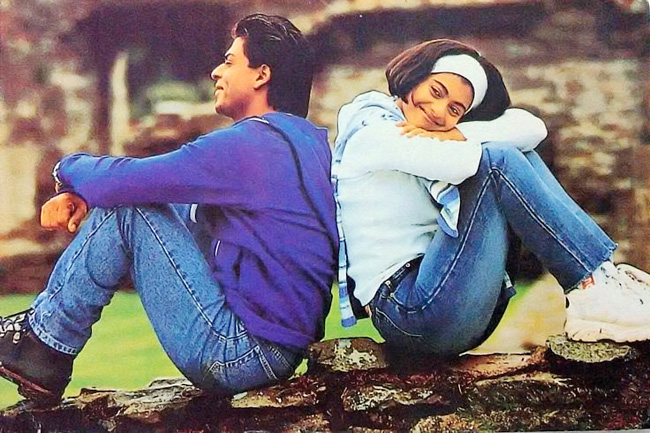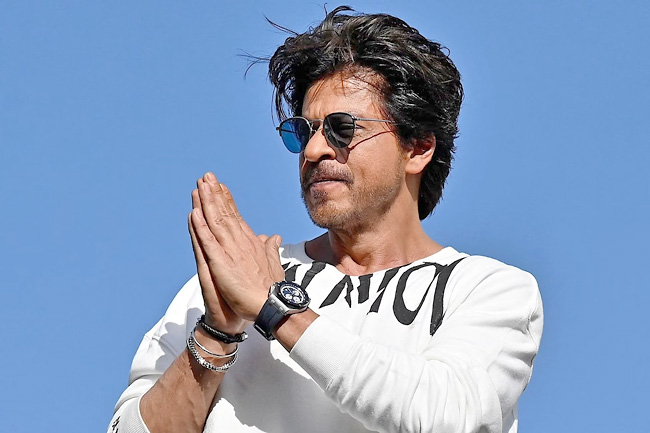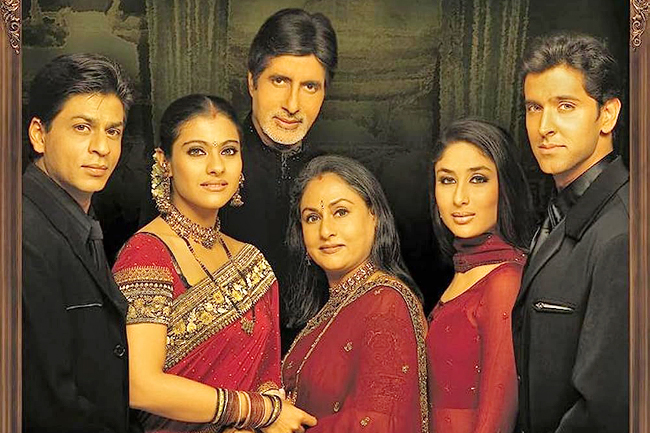ANN/THE DAILY STAR – Game-changing film titled Dilwale Dulhania Le Jayenge (DDLJ) made its debut in 1995, marking a revolutionary moment in the Hindi film industry and establishing Shah Rukh Khan as its third superstar. Before SRK, the esteemed title of ‘Superstar’ had been reserved for icons such as Amitabh Bachchan and Rajesh Khanna.
Through a strategic selection of films, DDLJ, among others, played a crucial role in propelling SRK from a mere star to a bona fide superstar.
Through a diverse array of characters and compelling stories, the charismatic Shah Rukh Khan captured the hearts of people from various backgrounds and religions across South Asia.
But how did he manage to resonate with such a vast and varied fan base? This article aims to explore the intricacies of how Shah Rukh Khan made his mark on the collective consciousness of the masses during his time.
Director of DDLJ Aditya Chopra and the elder son of Yash Chopra, had an unwavering passion for cinema since his childhood. He frequently visited movie theatres to watch films, even the unsuccessful and poorly made ones.
While watching the films, Aditya used to diligently take notes, jotting down various details about the film, including its box office estimates, analysis, and potential future success.
Filmmaker Karan Johar and Author Anupama Chopra both, in their respective books, highlighted Aditya’s intense fascination with and meticulous observation of Hindi films.
Due to his deep immersion in the world of cinema, Aditya had a keen understanding of what the audience desired in Hindi films, and this greatly influenced his filmmaking approach.





DDLJ, Aditya’s directorial debut, was strategically timed. In 1991, following economic liberalisation, India experienced a significant transformation in people’s lives.
This economic reform reshaped the urban landscape of India, opening up markets to a flood of foreign goods, from cereals to jeans and branded products. Emerging cable channels began to find their spots in living rooms. People’s attention began to shift towards the West.
There was an increase in their disposable income, leading to a rise in the number of middle-class households.
This rapid Western-influenced modernisation, along with its allure of glamour and sumptuous lifestyle, began to find its way into middle-class homes.
During that time, India witnessed a unique cultural juxtaposition. Western influences had arrived, but the echoes of old Indian traditions still lingered.
People were caught between tradition and modernity, grappling with dilemmas and insecurity.
Collectively, these changes caused a sense of uncertainty regarding the identity of the younger generation. Modernity’s sudden impact started raising questions within society, forcing them to ponder – what does it really mean to be Indian?
Through Aditya Chopra’s Raj character, Shah Rukh provided a persuasive response to this question. In DDLJ, Raj is an Indian who could straddle both worlds – a modernity that allowed for material comfort from the West while embracing the spiritual comfort of the East.
SRK’s character, a second-generation immigrant in London, could be seen enjoying a drink, donning a Harley Davidson jacket, and indulging in casual dates, yet he does not take advantage of the female lead, Simran – solely because he identifies himself as a ‘Hindustani’, someone who respects the traditional values of Indian womanhood. He even observes a fast on Karva Chauth (a Hindu festival) with his lover.
SRK’s portrayal of this character became a recurring theme in several subsequent films, and Aditya Chopra initiated this archetype while Karan Johar carried it forward. Together, Aditya and Karan shaped the Raj/Rahul persona, which resonated with a new generation of Indians as the face of the new millennium.
In Karan Johar’s Kuch Kuch Hota Hai, Shah Rukh Khan portrays a character who wears Gap and Polo t-shirts, living a Western-style college life, yet on Mondays, he goes to the temple.
In Kabhi Khushi Kabhie Gham, he takes on the character of an affluent man who has studied in London, yet his love and sense of duty towards his parents embody traditional values.
In movies like Kuch Kuch Hota Hai, Dil To Pagal Hai, Kabhi Khushi Kabhie Gham, Kal Ho Na Ho, and others, SRK’s portrayal of characters like Raj/Rahul conveyed that international designer clothes and a modern lifestyle cannot undermine the essence of Indian identity.
This persona encapsulated the face of a new consumeristic society in India. SRK personified the new millennium Indian – someone who harmoniously blends a global outlook with classical values and feels comfortable navigating the world while staying rooted in their Indian identity.
Shah Rukh Khan’s rise to superstardom owes much to his relentless hard work and exceptional skills, with Aditya Chopra and Karan Johar playing crucial roles in this journey.
This pattern is not entirely new. In a similar vein, Salim Khan and Javed Akhtar played significant roles in Amitabh Bachchan’s ascent to superstardom.
In the 1970s, during the shaping of Amitabh’s iconic ‘angry young man’ persona, these two scriptwriters played a pivotal role. In their film Zanjeer, this dynamic duo relentlessly lobbied for Amitabh to take on the lead role.
At that time, Amitabh had faced numerous setbacks and delivered a string of unmemorable movies, except for one – Anand, in which he plays a supporting role. However, the turning point in his career was Zanjeer, which marked the beginning of Amitabh’s stardom.
Through this movie, his ‘angry young man’ persona left an indelible mark on the collective consciousness of the people and was subsequently defined in various other films.
In the 1970s, the duo of Salim and Javed consistently featured Amitabh’s iconic persona in several films like Zanjeer, Deewar, Sholay, Trishul, Don, Kaala Patthar, etc.
Amongst these, Deewar (1975), written by Salim-Javed, stood out as a landmark film. With this film, Amitabh’s journey towards becoming a superstar truly took off. Deewar is often regarded as one of the best films of the 1970s.
In each of the mentioned films, Amitabh’s character typically goes by the name of Vijay/Jai.
In most of these movies, he grapples with societal injustices, discrimination, and the consequences of immorality, becoming internally traumatised and later driven by anger. Love and affection often take a backseat in his life, as his thoughts are directed elsewhere.
At times, he stands against injustice, while at other times, he gets entangled in the world of crime due to pressure from the system.
In the 1970s, the Indian populace was deeply connected to the prevailing anger. The year 1971 marked the end of the war, but in society, there were conflicts, corruption, poverty, unemployment, and a rise in organised crime.
Honest individuals were victims of oppression, and societal unrest was at its peak. Ordinary people were frustrated for various reasons.
In this tumultuous context, Salim-Javed skillfully tapped into the emotions and experiences of the people. They crafted the character of Vijay/Jai.
Through these character-driven narratives, the films mirrored and unified society’s anger and dissatisfaction, providing cinematic voices to those emotions.
Amidst the profound discontent in society, the sugary romance in Hindi films became intolerable for the audience.
Hindi movies, known for their everlasting fantasy and romance, turned to embrace Amitabh’s Vijay avatar, veering away from their traditional romantic fare.
Shah Rukh Khan grew up watching Amitabh Bachchan’s movies and was deeply influenced by them. He had a keen interest in action films. Many believe that at the beginning of his career, in movies like Baazigar and Darr, he took on anti-hero roles, which were quite risky choices.
In reality, this was a calculated risk, as Shah Rukh was aware that even Amitabh Bachchan had played anti-hero characters at the start of his career. Therefore, Shah Rukh Khan didn’t hesitate to take on such roles.
However, in the 1990s, Bollywood witnessed a decline in action movies and a resurgence in soft romances. While Salman Khan and Aamir Khan gained popularity with their romantic films during that period, Shah Rukh Khan was contemplating whether he was genuinely suited for pure romantic roles.
That’s when Aditya Chopra approached him with the script for DDL, but SRK was a bit hesitant. During the shooting of Darr, Aditya and Shah Rukh developed a friendship and rapport.
SRK knew that Aditya was going to make a film soon, but he expected it to be more in the thriller genre, like Baazigar or Darr. However, Aditya had a different plan. He believed that for Shah Rukh, it was time to embrace a romantic role, just as Salim-Javed had recognised Amitabh as the ideal Vijay, an angry young man.
Aditya had a strong conviction about Shah Rukh. On the set of the film Trimurti, he once told Shah Rukh that while he could choose not to do DDLJ, however, he shouldn’t turn away from romantic films.
He believed that in their country, a superstar would emerge from being every mother’s son, every sister’s brother, and the fantasy of every college girl. In the end, Shah Rukh agreed, and the result – the birth of a superstar in Hindi cinema.
Aditya inherited his filmmaking style from Yash Chopra, however, there was another person who profoundly influenced him – Sooraj Barjatya, the director of Maine Pyar Kiya. Barjatya, in his film, portrays Indian family values and relationships, more specifically, the idea of seeking parental consent before officially tying the knot.
Aditya Chopra embraced this concept from Maine Pyar Kiya and incorporated it into his filmmaking, emphasising the concept.
In DDLJ, even though Raj was brought up abroad, he remained deeply rooted in Indian values. He didn’t contemplate taking Simran away until her father willingly handed her over.
In one particular scene, amidst a picturesque Punjab setting, Raj dons a Harley Davidson jacket and tries to convince Simran that he would marry her only with her father’s wholehearted approval. DDLJ asserts that familial approval is necessary for love to thrive.
Until then, most love stories in Hindi Cinema portrayed love as a rebellious act. Heroes and heroines fought battles and sometimes even died in pursuit of love. DDLJ brought about a narrative shift.
The hero doesn’t want to elope; he wants to win over the heroine’s father’s heart to get her. This movie made young audiences happy and parents too.
The climax of DDLJ is one of the reasons for its immense popularity. At the same time, the audience fell in love with SRK’s portrayal of Raj, and, consequently, with Shah Rukh himself.
During the shooting of DDLJ, Karan developed a friendship with Shah Rukh Khan. Karan instinctively understood that going forward with this Raj persona in their upcoming films would be an advantageous partnership for them.
Meanwhile, DDLJ had already started attracting the non-resident Indians (NRIs). Karan tapped into this market as well.
Karan played an instrumental role in elevating SRK to a global icon. He understood what the NRI audience desired.
In his words, “Their desire is a grand Indian joyride, where beautiful actors and actresses adorn themselves in Western attire, engage in sweet conversations, and teach their children Indian values and culture.” Through films like Kuch Kuch Hota Hai, Kabhi Khushi Kabhie Gham, and more, Karan delivered precisely that. The second-generation immigrant youths, like the Raj/Rahul character, found a star they could connect with.
An Indian, financially well-off, donning Western designer clothes – a representation of aspiration. NRI parents also appreciated this persona, as it provided an aspirational balance for their Westernised children.
Before DDLJ and Kuch Kuch Hota Hai, NRIs did not find representation in Bollywood. Yash Chopra, Aditya Chopra, and their protege Karan collectively carved a niche for NRIs in Hindi cinema. Consequently, in 1997, Yash Raj Films opened its distribution office in England, and Dil Toh Pagal Hai grossed an unprecedented GBP1 million.
While there might have been a resemblance between Salman’s first on-screen image and Raj persona, it was Karan Johar and Yash Raj Films’ subsequent films that solidified the personas of Raj/Rahul for SRK.
Not only that, but Shah Rukh’s off-screen personality was also carefully presented to the public. He was portrayed as a family man hailing from a middle-class background.
Audiences could intuitively sense a remarkable similarity between Shah Rukh on and off-screen. Rather than appearing as a distant celebrity, he came across as a relatable figure, like a neighbour’s son.
The line between Shah Rukh’s on-screen character and his authentic self seemed to blur in the eyes of the audience.
In contrast, India’s first superstar, Rajesh Khanna, couldn’t replicate the same connection with his audience. Despite being hysterically popular for his image of a liberated lover on-screen, his reputation quickly declined.
One of the many reasons was the various personal issues, including insecurities, marital conflicts, and family problems, which were widely covered in newspapers and magazines.
As a result, the illusion he had created for his audience on screen didn’t align with reality.
The gap between his reel and real life became quite pronounced.
Creating the Raj/Rahul image involves careful attention to certain elements that deeply resonate with people. It aims to touch the chords of the human heart.
Here’s an example: Raj/Rahul embodies both modern and traditional qualities simultaneously.
In most films, he is devoted to his mother and also respects motherly figures. Mothers love him, too.
There is usually a significant scene involving a motherly figure. Prior to DDLJ, such elements were present in many films, but they were primarily for narrative purposes.
However, after DDLJ, these aspects are highlighted separately.
In movies like Kuch Kuch Hota Hai, Duplicate, Yes Boss, Kabhi Khushi Kabhie Gham, Kal Ho Naa Ho, My Name Is Khan, and even in the 2023 film Pathaan, there is a scene where Shah Rukh saves children and people from a bomb attack in Afghanistan.
Then, an Afghan mother, a humble woman, ties an amulet around Shah Rukh’s arm, saying that no Pathan mother could have given birth to such a brave son. She prays for his safety.
Like this, in various ways, a sense of trust and affection is gradually being cultivated for Shah Rukh within the Hindi cinema audience. – Rafid Hossain



